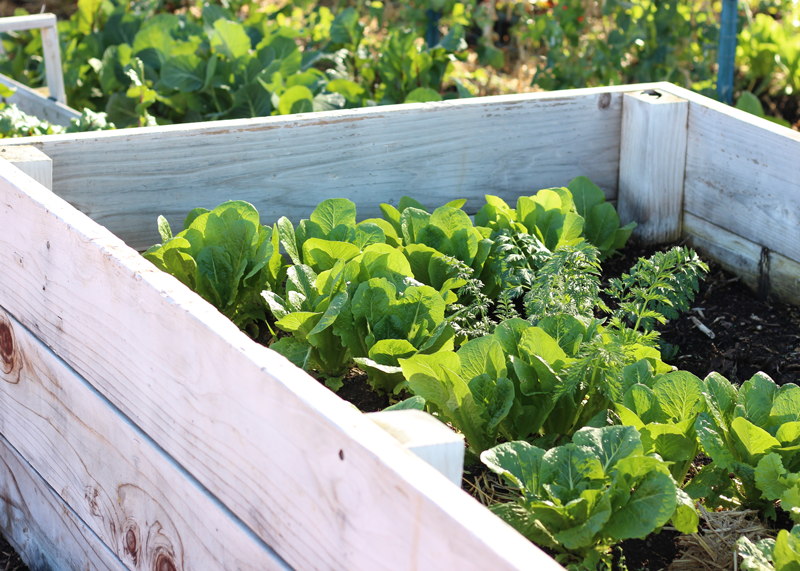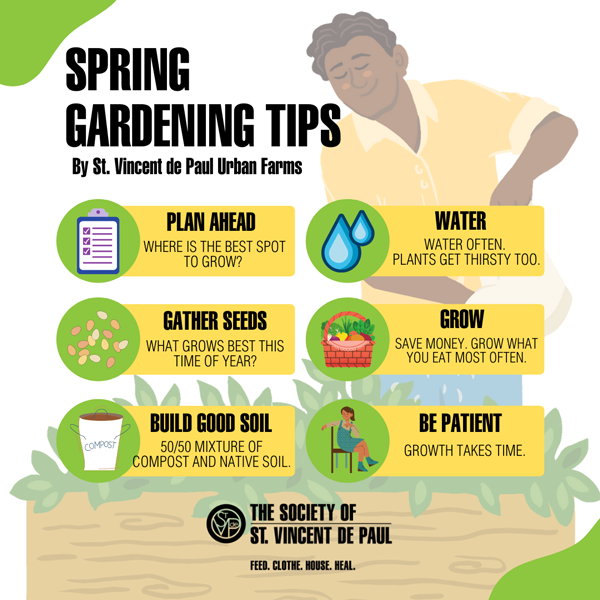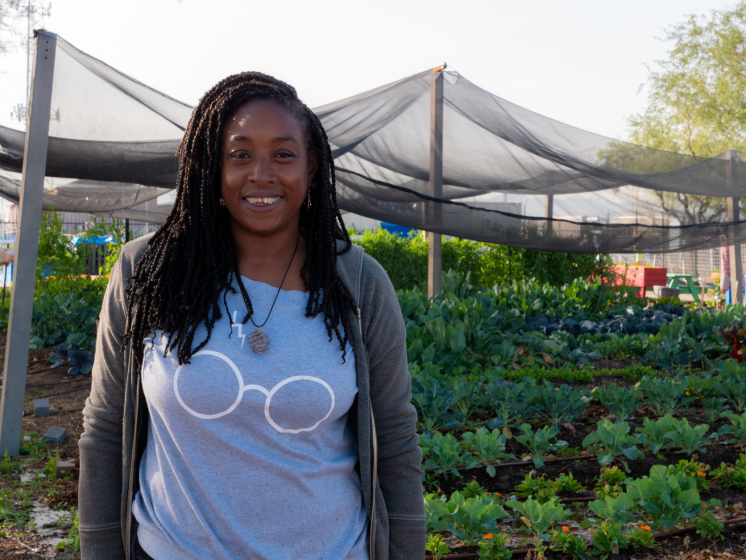
7 spring gardening tips from SVdP's Urban Farm manager
Spring is an exciting time in the Valley for those of us who like to grow. The Valley is in full bloom and the weather is perfect for outdoor activities, including gardening. Growing your own fruits and veggies may seem difficult at times but with a few tips and some research on your part, you too can grow a beautiful and self-sustaining garden that feeds your family and helps pollinators at the same time.
While there are various sources that will give you plenty of information on how to grow all kinds of plants in the Valley, it is ultimately up to you and the effort you put into the space that will determine how productive or unproductive your space will be.
In an effort to make your garden experience a fun and productive one, below are a few tips to help you on your Spring planting journey!

Tip 1: Plan Ahead
When you have a plan about where you want to get materials, what you want to grow and how much time you have to put into making your space a flourishing one, it will make your spring growing season a less stressful one, and you may be motivated to extend your growing into the summer months.
Tip 2: Soil
When gathering material for your garden, always look through what you may have at home first to save yourself some money. For instance, if you have a bucket with a lid, that will work perfectly for composting which you will definitely need to keep plants fed and healthy.
If you aren't building your own soil and need to purchase soil, remember to always shop local and support small, family-run operations when you can. There are a number of family-owned and operated farms in the Valley that sell good quality soil at a reasonable price. Two of my favorites are Singh Family Farms and The Arizona Worm Farm. They are especially great anytime I'm needing extra soil for our Urban Farms and SVdP.
Tip 3: Seeds
Depending on who you ask, the type of seeds you plant in your grow space can make or break your production. Going the organic, non-gmo, heirloom route is always the best way to go. These mentioned types of seeds are generally passed down because of their resilience and productivity. Planting seeds that will survive Arizona's sometimes fluctuating temperatures and harsh soil conditions is definitely a good look for growers who want a nice harvest at the end of the season and are also consciously aware of the environmental impacts of various styles of food production. Again, shopping locally will be of great benefit to you and your garden in the long run when it comes to seeds. I like ordering seeds from Native Seeds in Tucson and have found they almost always guarantee me a productive growing season here in the Valley.
Tip 4: Plant what you eat
Planting what you eat most often will save you and your family money and time at the grocery store. If you are the type of person that eats tons of tomatoes in a week, whether in a salad or to make your own sauces, planting tomatoes at home could save you a couple hundred dollars a year. For example, a pack of seeds can cost anywhere between $1.00 - $1.75 depending on the seed brand.There are at least 10 seeds in one pack. One tomato plant can yield 10-30 pounds of tomatoes. The average cost of a pound of tomatoes is $1.91. With just one plant you have the potential to produce $57 worth of tomatoes, if you grow all ten, you have the potential to produce $570 worth of tomatoes and have plenty to share with friends and family. Those savings and food security is always helpful, but especially so in tough economic times.
Tip 5: Grow what’s in season
Seasonal planting is also so important to your productivity and the environment. For instance, vegetables like parsnips and cauliflower are best grown in the cooler months and do not do well in our warmer temperatures. Even though those of us who live in the Valley don't get snow and don't have to take extreme measures to keep our food from freezing, we do have to worry about growing foods that can sustain our heat waves, which is a big part of producing good quality food. For the spring months you can get started on planting cucumbers, summer squash, watermelon, sunflowers and other hydrating foods like tomatoes and honeydew. For more information on what you can plant during the spring and summer months, I recommend visiting the University of Arizona's Cooperative Extension website and using their Planting Calendar for Maricopa County.
Tip 6: Water
Watering is so critical to the health of your plants here in Arizona. Just like we need water to survive, so do our plant babies. Making sure you are watering daily during the summer months is a must. During the spring, you can get away with watering your plants every 2-3 days depending on how deep you water them. Most plants need at least watering at least one foot deep for inground plants and four inches for plants in pots or containers. It can get a little tricky because overwatering can be just as detrimental to your plants as underwatering. A sign that you may be overwatering is yellowing of the leaves and a sign that you are underwatering is browning of your leaves. Remember that just like with any living thing, as you devote time to it, you discover its unique needs and cycles, so have that same patience as you learn how best to care for and keep your plants happy.
Tip 7: Shade
I cannot stress enough to people how important shade is to our veggies and other plants here in the Valley. Most of the time when you go to the plant store there will be a tag that says “Full Sun.” Let's be clear: They are not talking about the Arizona sun and the extreme sunshine and heat it provides. You will always have to counterbalance the extreme sun of Arizona, so it's absolutely necessary to provide your plants with some shade during the hottest part of the day in the Valley. If you are planning on planting but don't want to buy or build shade, plant your veggies under a tree or grow them in buckets so that you can move them easily if you notice sunburn. Tomatoes, which are one vegetable people grow here during the spring and summer months, should definitely have shade or they will get sunburn. If you are planting summer squash, you may notice that your leaves will sag during the hottest parts of the day but will spring right back up once the sun starts to set. Certain crops can take the heat a lot better than other vegetables along with pepper, watermelon and cantaloupe.

Nika Forte is the Urban Farm manager at St. Vincent de Paul and helps the farm team produce hundreds of pounds of food each month for the nonprofit to use in its kitchen and give to families in need. You'll often find Nika at SVdP's Urban Farm located next to the Phoenix Dining Room on the Human Services Campus. Nika is also an expert beekeeper and sustainability advocate with rich knowledge on pollinators, composting and soil management.



